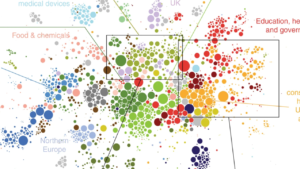
LinkedIn Data Helps to Create the First-Ever Global Map of Labor Flow

LinkedIn and Indiana University have published what they are calling “the first ever map of global labor flow.” The research – which was published in August’s issue of Nature Communications – used a massive amount of LinkedIn employment history data to build a labor flow network.
The research examined geographically defined groups of interconnected firms called “geo-industrial clusters” – e.g. Silicon Valley (for technology companies) or Hollywood (for the film industry). The authors argue that prior research used poorly defined notions of geo-industrial clusters and relied on limited empirical data, mostly leaving the research to focus on case studies rather than conducting systemic analyses.
Enter LinkedIn, which provided access to its employment history data from more than 500 million users over the course of 25 years. The authors leveraged this data to create an organic method for identifying geo-industrial clusters. First, they identified concentrated labor flows among more than 4 million firms by analyzing roughly 130 million job transitions.
“[The] structure of this global labor flow network,” the authors wrote, “reveals the multi-scale hierarchical organization of geo-industrial clusters, which constitute a natural, emergent unit of analysis for the global economy.” In order words: having access to that data allowed the researchers to create a new metric for identifying these industrial clusters.
Using this method, the authors “easily” identified clusters across domains, and the logic of the basic results is fairly straightforward (“Workers,” the study says, “tend to change their jobs between geographically close firms with similar skills requirements.”). They found strong industrial and geographic concentrations, also demonstrating that there were strong connections between the influx of educated workers and financial performance and productivity growth.
The authors note that their study isn’t comprehensive – after all, LinkedIn is a younger and U.S.-biased dataset, and large firms aren’t homogeneous entities that only employ people with one kind of skill set. Furthermore, the study only focuses on S&P 500 firms, limiting its applicability to industries that tend to consist of smaller companies.
Still, the authors argue that “even with these caveats, the labor flow network approach can provide powerful and novel ways to examine how economies are organized and evolve.”
































